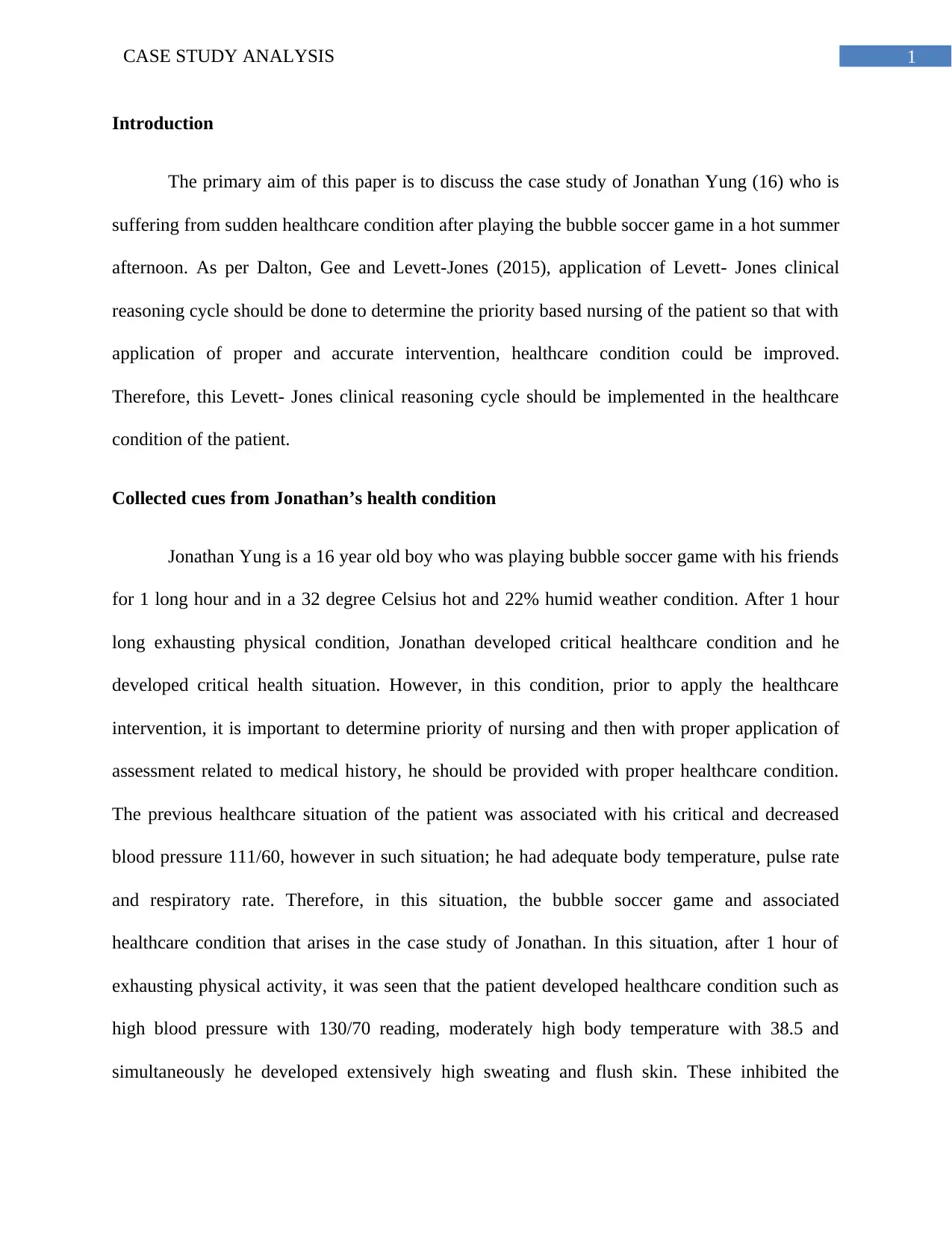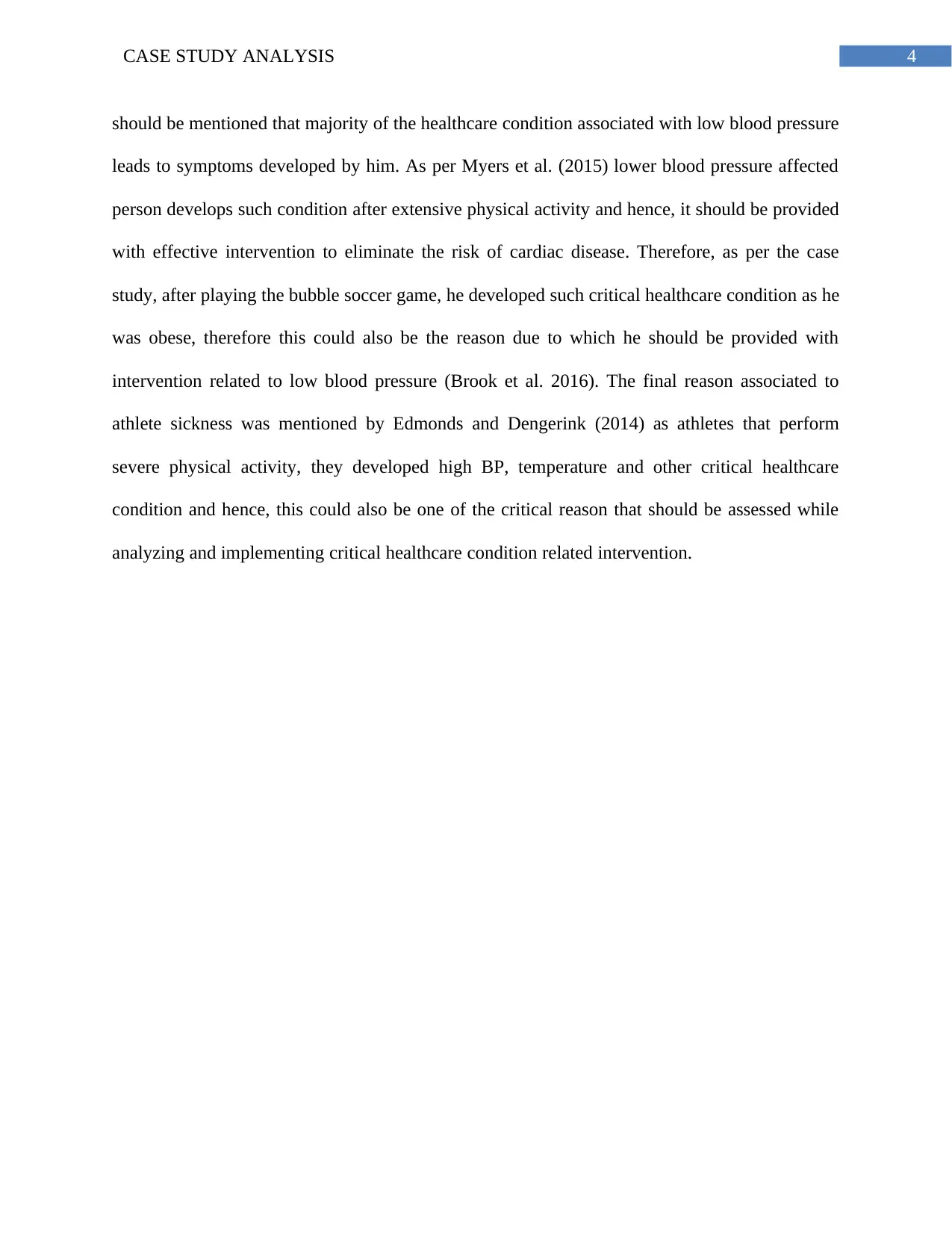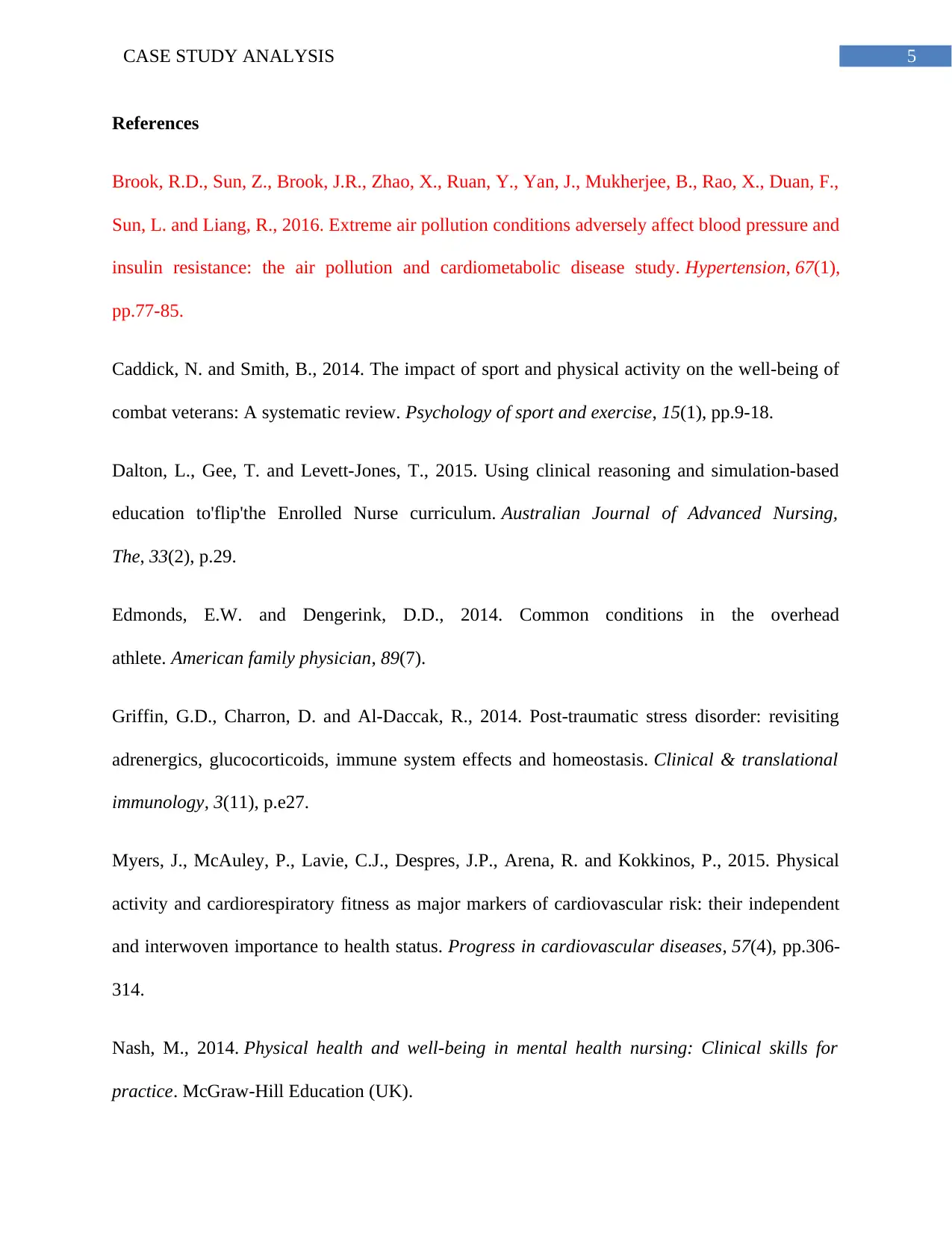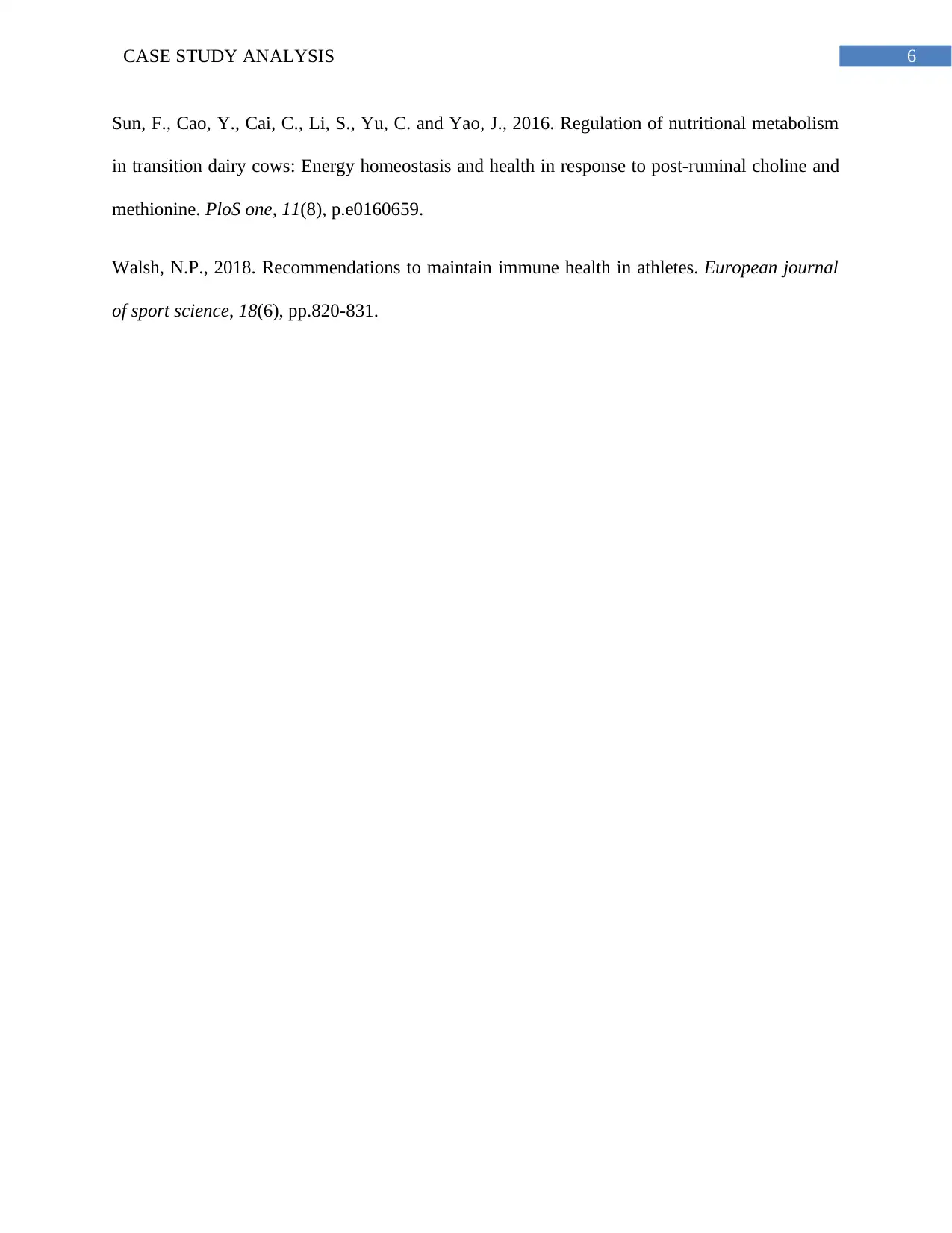Clinical Reasoning Report: Jonathan Yung Case Study Analysis - CNA152
VerifiedAdded on 2023/01/17
|7
|1634
|83
Report
AI Summary
This report presents a case study analysis of Jonathan Yung, a 16-year-old student who experienced health complications after playing bubble soccer in hot and humid weather. The student nurse, under supervision, assessed Jonathan's vital signs, revealing elevated temperature, pulse, and respiratory rates, along with an increased blood pressure. The report applies the Levett-Jones clinical reasoning cycle to analyze the collected cues, interpret the data, identify problems such as homeostasis imbalance and athletic sickness, and formulate potential nursing interventions. The analysis considers factors like Jonathan's previous low blood pressure, the strenuous physical activity, and the environmental conditions. The report references relevant research to support the findings and provides a comprehensive overview of the patient's condition and potential health risks. The analysis highlights the importance of timely and accurate healthcare interventions to address the identified health concerns.

Running head: CASE STUDY ANALYSIS
JONATHAN YUNG CASE STUDY ANALYSIS
Name of the student
Name of the university
Author note
JONATHAN YUNG CASE STUDY ANALYSIS
Name of the student
Name of the university
Author note
Paraphrase This Document
Need a fresh take? Get an instant paraphrase of this document with our AI Paraphraser

1CASE STUDY ANALYSIS
Introduction
The primary aim of this paper is to discuss the case study of Jonathan Yung (16) who is
suffering from sudden healthcare condition after playing the bubble soccer game in a hot summer
afternoon. As per Dalton, Gee and Levett-Jones (2015), application of Levett- Jones clinical
reasoning cycle should be done to determine the priority based nursing of the patient so that with
application of proper and accurate intervention, healthcare condition could be improved.
Therefore, this Levett- Jones clinical reasoning cycle should be implemented in the healthcare
condition of the patient.
Collected cues from Jonathan’s health condition
Jonathan Yung is a 16 year old boy who was playing bubble soccer game with his friends
for 1 long hour and in a 32 degree Celsius hot and 22% humid weather condition. After 1 hour
long exhausting physical condition, Jonathan developed critical healthcare condition and he
developed critical health situation. However, in this condition, prior to apply the healthcare
intervention, it is important to determine priority of nursing and then with proper application of
assessment related to medical history, he should be provided with proper healthcare condition.
The previous healthcare situation of the patient was associated with his critical and decreased
blood pressure 111/60, however in such situation; he had adequate body temperature, pulse rate
and respiratory rate. Therefore, in this situation, the bubble soccer game and associated
healthcare condition that arises in the case study of Jonathan. In this situation, after 1 hour of
exhausting physical activity, it was seen that the patient developed healthcare condition such as
high blood pressure with 130/70 reading, moderately high body temperature with 38.5 and
simultaneously he developed extensively high sweating and flush skin. These inhibited the
Introduction
The primary aim of this paper is to discuss the case study of Jonathan Yung (16) who is
suffering from sudden healthcare condition after playing the bubble soccer game in a hot summer
afternoon. As per Dalton, Gee and Levett-Jones (2015), application of Levett- Jones clinical
reasoning cycle should be done to determine the priority based nursing of the patient so that with
application of proper and accurate intervention, healthcare condition could be improved.
Therefore, this Levett- Jones clinical reasoning cycle should be implemented in the healthcare
condition of the patient.
Collected cues from Jonathan’s health condition
Jonathan Yung is a 16 year old boy who was playing bubble soccer game with his friends
for 1 long hour and in a 32 degree Celsius hot and 22% humid weather condition. After 1 hour
long exhausting physical condition, Jonathan developed critical healthcare condition and he
developed critical health situation. However, in this condition, prior to apply the healthcare
intervention, it is important to determine priority of nursing and then with proper application of
assessment related to medical history, he should be provided with proper healthcare condition.
The previous healthcare situation of the patient was associated with his critical and decreased
blood pressure 111/60, however in such situation; he had adequate body temperature, pulse rate
and respiratory rate. Therefore, in this situation, the bubble soccer game and associated
healthcare condition that arises in the case study of Jonathan. In this situation, after 1 hour of
exhausting physical activity, it was seen that the patient developed healthcare condition such as
high blood pressure with 130/70 reading, moderately high body temperature with 38.5 and
simultaneously he developed extensively high sweating and flush skin. These inhibited the

2CASE STUDY ANALYSIS
normal health condition of the patient and caused him suffer from critical healthcare condition.
Hence, these are the cues that should be collected and processed for understanding the healthcare
intervention for Jonathan.
Analysis and interpretation of the collected cues
In this case study, it was mentioned that the patient had low blood pressure in the past
and despite this he performed 1 hour long strenuous and exhausting bubble soccer game in a
sunny and humid summer afternoon. As per Edmonds and Dengerink (2014), in such healthcare
condition, lower blood pressure could be critical and severe healthcare condition, as in such
condition, if any one performs exhausting healthcare condition, then their heart beat and
respiratory rate increases and hence, their blood pressure also increases so that their requirement
of blood and oxygen could be met. Another factor that could be associated with this healthcare
condition is the homeostasis balance, due to which all the bodily organs, glands and up to the
tissue and cellular level is controlled and with this, the gas exchange, blood pressure, blood flow
and other system functions properly (Griffin, Charron and Al‐Daccak 2014). As per Sun et al.
(2016), disruption of this body balance could be another reason due to which such healthcare
condition arises and the patient Jonathan developed such healthcare condition. Another research
finding should be included in this aspect as Myers et al. (2015) mentioned that with increased
physical activity, risk of cardiac diseases and other healthcare condition such as increased pulse
and cardiac rate increases. Similar aspect was observed in the healthcare condition of Brook et
al. (2016) as it was seen that the patient developed critical healthcare condition in with the
occurrence of increased blood pressure and body temperature. Similarly due to the critical
healthcare condition, the occurrence of severe healthcare condition related to anxiety,
dehydration, extensive sweating and hence, risk of severe healthcare condition increased for
normal health condition of the patient and caused him suffer from critical healthcare condition.
Hence, these are the cues that should be collected and processed for understanding the healthcare
intervention for Jonathan.
Analysis and interpretation of the collected cues
In this case study, it was mentioned that the patient had low blood pressure in the past
and despite this he performed 1 hour long strenuous and exhausting bubble soccer game in a
sunny and humid summer afternoon. As per Edmonds and Dengerink (2014), in such healthcare
condition, lower blood pressure could be critical and severe healthcare condition, as in such
condition, if any one performs exhausting healthcare condition, then their heart beat and
respiratory rate increases and hence, their blood pressure also increases so that their requirement
of blood and oxygen could be met. Another factor that could be associated with this healthcare
condition is the homeostasis balance, due to which all the bodily organs, glands and up to the
tissue and cellular level is controlled and with this, the gas exchange, blood pressure, blood flow
and other system functions properly (Griffin, Charron and Al‐Daccak 2014). As per Sun et al.
(2016), disruption of this body balance could be another reason due to which such healthcare
condition arises and the patient Jonathan developed such healthcare condition. Another research
finding should be included in this aspect as Myers et al. (2015) mentioned that with increased
physical activity, risk of cardiac diseases and other healthcare condition such as increased pulse
and cardiac rate increases. Similar aspect was observed in the healthcare condition of Brook et
al. (2016) as it was seen that the patient developed critical healthcare condition in with the
occurrence of increased blood pressure and body temperature. Similarly due to the critical
healthcare condition, the occurrence of severe healthcare condition related to anxiety,
dehydration, extensive sweating and hence, risk of severe healthcare condition increased for
⊘ This is a preview!⊘
Do you want full access?
Subscribe today to unlock all pages.

Trusted by 1+ million students worldwide

3CASE STUDY ANALYSIS
Jonathan after the critical situation. This is related to his game play as majority of the researchers
has mentioned that such condition could lead to critical healthcare condition as similar condition
was observed in case of Jonathan (Walsh 2018). Besides these explanations, another concept of
hormonal change in excessive physical condition should be discussed as adrenaline is the
hormone that increases with physical activity and dilates the blood vessels and in this situation
the heart pumps faster than the regular health condition and leads to critical health outcomes if
not controlled properly (Caddick and Smith 2014). These are the cues that should be collected
and processed for identification of the reasons that arises in the healthcare condition of Jonathan
mentioned in the case study.
Identification of problems
After collection of the cues as per the Dalton, Gee and Levett-Jones (2015), the health
information of Jonathan should be processes and arranged for identification of healthcare
complication of the patient. As per the collected cues, three aspect arises as the primary aspect of
the healthcare of Jonathan and these are his homeostasis imbalance, his athletic sickness and
associated healthcare complications. Homeostasis imbalance is a crucial health complication that
could affect the physical balance of the patient (Nash 2014). As mentioned in the case study,
after playing the exhausting game of bubble soccer the patient starts feeling restlessness, started
sweating extremely and then with increased blood pressure developed anxiety. These are the
condition that arises due to the healthcare condition of homeostasis imbalance and as per Griffin,
Charron and Al‐Daccak (2014), affected the healthcare condition of the patient. Sun et al. (2016)
also mentioned that improper homeostasis balance could lead to critical healthcare condition and
in such situation intensive sweating and flush skin and heart rate, pulse rate and respiratory rate
increased. Hence, this was the critical issue associated with health of Jonathan. After this, it
Jonathan after the critical situation. This is related to his game play as majority of the researchers
has mentioned that such condition could lead to critical healthcare condition as similar condition
was observed in case of Jonathan (Walsh 2018). Besides these explanations, another concept of
hormonal change in excessive physical condition should be discussed as adrenaline is the
hormone that increases with physical activity and dilates the blood vessels and in this situation
the heart pumps faster than the regular health condition and leads to critical health outcomes if
not controlled properly (Caddick and Smith 2014). These are the cues that should be collected
and processed for identification of the reasons that arises in the healthcare condition of Jonathan
mentioned in the case study.
Identification of problems
After collection of the cues as per the Dalton, Gee and Levett-Jones (2015), the health
information of Jonathan should be processes and arranged for identification of healthcare
complication of the patient. As per the collected cues, three aspect arises as the primary aspect of
the healthcare of Jonathan and these are his homeostasis imbalance, his athletic sickness and
associated healthcare complications. Homeostasis imbalance is a crucial health complication that
could affect the physical balance of the patient (Nash 2014). As mentioned in the case study,
after playing the exhausting game of bubble soccer the patient starts feeling restlessness, started
sweating extremely and then with increased blood pressure developed anxiety. These are the
condition that arises due to the healthcare condition of homeostasis imbalance and as per Griffin,
Charron and Al‐Daccak (2014), affected the healthcare condition of the patient. Sun et al. (2016)
also mentioned that improper homeostasis balance could lead to critical healthcare condition and
in such situation intensive sweating and flush skin and heart rate, pulse rate and respiratory rate
increased. Hence, this was the critical issue associated with health of Jonathan. After this, it
Paraphrase This Document
Need a fresh take? Get an instant paraphrase of this document with our AI Paraphraser

4CASE STUDY ANALYSIS
should be mentioned that majority of the healthcare condition associated with low blood pressure
leads to symptoms developed by him. As per Myers et al. (2015) lower blood pressure affected
person develops such condition after extensive physical activity and hence, it should be provided
with effective intervention to eliminate the risk of cardiac disease. Therefore, as per the case
study, after playing the bubble soccer game, he developed such critical healthcare condition as he
was obese, therefore this could also be the reason due to which he should be provided with
intervention related to low blood pressure (Brook et al. 2016). The final reason associated to
athlete sickness was mentioned by Edmonds and Dengerink (2014) as athletes that perform
severe physical activity, they developed high BP, temperature and other critical healthcare
condition and hence, this could also be one of the critical reason that should be assessed while
analyzing and implementing critical healthcare condition related intervention.
should be mentioned that majority of the healthcare condition associated with low blood pressure
leads to symptoms developed by him. As per Myers et al. (2015) lower blood pressure affected
person develops such condition after extensive physical activity and hence, it should be provided
with effective intervention to eliminate the risk of cardiac disease. Therefore, as per the case
study, after playing the bubble soccer game, he developed such critical healthcare condition as he
was obese, therefore this could also be the reason due to which he should be provided with
intervention related to low blood pressure (Brook et al. 2016). The final reason associated to
athlete sickness was mentioned by Edmonds and Dengerink (2014) as athletes that perform
severe physical activity, they developed high BP, temperature and other critical healthcare
condition and hence, this could also be one of the critical reason that should be assessed while
analyzing and implementing critical healthcare condition related intervention.

5CASE STUDY ANALYSIS
References
Brook, R.D., Sun, Z., Brook, J.R., Zhao, X., Ruan, Y., Yan, J., Mukherjee, B., Rao, X., Duan, F.,
Sun, L. and Liang, R., 2016. Extreme air pollution conditions adversely affect blood pressure and
insulin resistance: the air pollution and cardiometabolic disease study. Hypertension, 67(1),
pp.77-85.
Caddick, N. and Smith, B., 2014. The impact of sport and physical activity on the well-being of
combat veterans: A systematic review. Psychology of sport and exercise, 15(1), pp.9-18.
Dalton, L., Gee, T. and Levett-Jones, T., 2015. Using clinical reasoning and simulation-based
education to'flip'the Enrolled Nurse curriculum. Australian Journal of Advanced Nursing,
The, 33(2), p.29.
Edmonds, E.W. and Dengerink, D.D., 2014. Common conditions in the overhead
athlete. American family physician, 89(7).
Griffin, G.D., Charron, D. and Al‐Daccak, R., 2014. Post‐traumatic stress disorder: revisiting
adrenergics, glucocorticoids, immune system effects and homeostasis. Clinical & translational
immunology, 3(11), p.e27.
Myers, J., McAuley, P., Lavie, C.J., Despres, J.P., Arena, R. and Kokkinos, P., 2015. Physical
activity and cardiorespiratory fitness as major markers of cardiovascular risk: their independent
and interwoven importance to health status. Progress in cardiovascular diseases, 57(4), pp.306-
314.
Nash, M., 2014. Physical health and well-being in mental health nursing: Clinical skills for
practice. McGraw-Hill Education (UK).
References
Brook, R.D., Sun, Z., Brook, J.R., Zhao, X., Ruan, Y., Yan, J., Mukherjee, B., Rao, X., Duan, F.,
Sun, L. and Liang, R., 2016. Extreme air pollution conditions adversely affect blood pressure and
insulin resistance: the air pollution and cardiometabolic disease study. Hypertension, 67(1),
pp.77-85.
Caddick, N. and Smith, B., 2014. The impact of sport and physical activity on the well-being of
combat veterans: A systematic review. Psychology of sport and exercise, 15(1), pp.9-18.
Dalton, L., Gee, T. and Levett-Jones, T., 2015. Using clinical reasoning and simulation-based
education to'flip'the Enrolled Nurse curriculum. Australian Journal of Advanced Nursing,
The, 33(2), p.29.
Edmonds, E.W. and Dengerink, D.D., 2014. Common conditions in the overhead
athlete. American family physician, 89(7).
Griffin, G.D., Charron, D. and Al‐Daccak, R., 2014. Post‐traumatic stress disorder: revisiting
adrenergics, glucocorticoids, immune system effects and homeostasis. Clinical & translational
immunology, 3(11), p.e27.
Myers, J., McAuley, P., Lavie, C.J., Despres, J.P., Arena, R. and Kokkinos, P., 2015. Physical
activity and cardiorespiratory fitness as major markers of cardiovascular risk: their independent
and interwoven importance to health status. Progress in cardiovascular diseases, 57(4), pp.306-
314.
Nash, M., 2014. Physical health and well-being in mental health nursing: Clinical skills for
practice. McGraw-Hill Education (UK).
⊘ This is a preview!⊘
Do you want full access?
Subscribe today to unlock all pages.

Trusted by 1+ million students worldwide

6CASE STUDY ANALYSIS
Sun, F., Cao, Y., Cai, C., Li, S., Yu, C. and Yao, J., 2016. Regulation of nutritional metabolism
in transition dairy cows: Energy homeostasis and health in response to post-ruminal choline and
methionine. PloS one, 11(8), p.e0160659.
Walsh, N.P., 2018. Recommendations to maintain immune health in athletes. European journal
of sport science, 18(6), pp.820-831.
Sun, F., Cao, Y., Cai, C., Li, S., Yu, C. and Yao, J., 2016. Regulation of nutritional metabolism
in transition dairy cows: Energy homeostasis and health in response to post-ruminal choline and
methionine. PloS one, 11(8), p.e0160659.
Walsh, N.P., 2018. Recommendations to maintain immune health in athletes. European journal
of sport science, 18(6), pp.820-831.
1 out of 7
Related Documents
Your All-in-One AI-Powered Toolkit for Academic Success.
+13062052269
info@desklib.com
Available 24*7 on WhatsApp / Email
![[object Object]](/_next/static/media/star-bottom.7253800d.svg)
Unlock your academic potential
Copyright © 2020–2025 A2Z Services. All Rights Reserved. Developed and managed by ZUCOL.





